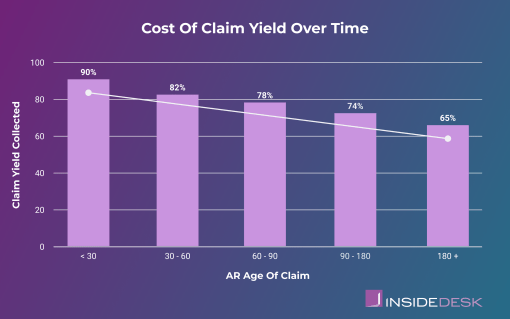When it comes to dental claims, not all are created equal. Understanding the nuances of filing claims and the ability to close claims in a timely and efficient manner can make a significant difference in maximizing their value. But how much is your claim really worth?
What is Dental Claim Yield and Are You Measuring It?
To understand the true value of your dental claims, it’s essential to grasp the concept of claim yield. Claim yield refers to the ratio of the total amount collected from insurance payors to the total amount expected. Essentially, it measures how effectively you convert production into collected revenue.
What Affects Claim Yield?
Several factors can influence claim yield. Aging Accounts Receivable (A/R) is one factor. As claims sit unpaid for longer periods, they become less likely to be reimbursed fully, if at all. Also, as unpaid claims age and time passes, it’s much easier for those unpaid claims to fall off our radar.
Additionally, incorrect coding, wrong codes, missing attachments, and bad submissions can all contribute to a decrease in claim yield by leading to claim denials or underpayments. Delays in filing can complicate matters further, making it harder and more time-consuming to gather necessary information such as updated patient insurance details or clinical narratives.
Thus, timely filing is crucial for optimizing claim yield and ensuring efficient revenue cycle management.
How Much is it Costing You?
“You can’t manage what you can’t measure.” This adage holds true when it comes to understanding the financial impact of your dental claims. InsideDesk offers a solution by delving into your system, pulling your fee schedules, and matching them with the reimbursements received from payors. By doing so, InsideDesk helps you understand your claim yield accurately.
To see the real costs of claim yield over time let’s take a look at the graph below. The difference between a claim being closed in less than 30 days from date of service vs a claim being closed in 180+ days is 28% reduction to the reimbursement. This is the importance of instituting an efficient process for quickly addressing and resolving claims, thereby maximizing financial returns.
One solution to recoup lost claim yield is transferring unpaid insurance balances to the patient. But put yourself in the patient’s shoes, imagine receiving a statement six months after visiting the dentist. You’d likely question the delay and validity. The longer it takes to present a remaining balance post-visit, the lower the likelihood of payment.
In conclusion, there are a number of KPIs that are used today to measure the health of your dental group. Optimizing your processes to maximize your claim yield is one of the most important factors in ensuring growth and sustainability. By understanding claim yield, identifying factors affecting claim yield, and measuring its impact accurately, you can take proactive steps to enhance your DSO’s financial health.
*Claim yield refers to the ratio of the total amount collected from insurance payors to the total amount expected.





